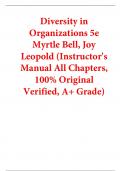Diversity in
Organizations 5e
Myrtle Bell, Joy
Leopold (Instructor's
Manual All Chapters,
100% Original
Verified, A+ Grade)
, Instructor Manual: Bell, Diversity in Organizations, 9780357986349; Chapter 1: Introduction
Instructor Manual
Bell & Leopold, Diversity in Organizations, 9780357986349; Chapter 1: Introduction
Table of Contents
Purpose and Perspective of the Chapter..................................................................................... 2
Cengage Supplements .................................................................................................................. 2
Chapter Objectives ........................................................................................................................ 2
What’s New in this Chapter........................................................................................................... 3
Chapter Outline ............................................................................................................................. 3
Discussion Questions .................................................................................................................... 4
Appendix ........................................................................................................................................ 6
Generic Rubrics ......................................................................................................................................... 6
Standard Writing Rubric ............................................................................................................................ 6
Standard Discussion Rubric ....................................................................................................................... 7
© 2025 Cengage. All Rights Reserved. May not be scanned, copied or duplicated, or posted to a publicly accessible 1
website, in whole or in part.
, Instructor Manual: Bell, Diversity in Organizations, 9780357986349; Chapter 1: Introduction
Purpose and Perspective of the Chapter
Diversity, equity, and inclusion are frequently used terms in diversity-related research,
organizations, and the media. As such, this book uses diversity; diversity and inclusion; and
diversity, equity, and inclusion to refer generally to related efforts to ensure that individuals
of all backgrounds are treated as valued applicants, employees, and customers. While
some research and organizations use slightly different terminology, the focus on ensuring
individuals of all backgrounds are valued and have opportunities to thrive and contribute
remains the same.
In this book, diversity is defined as real or perceived differences among people in race;
ethnicity; sex; age; physical and mental ability; sexual orientation; religion; work and family
status; weight and appearance; social class; and other identity-based areas that affect their
experiences, outcomes, and opportunities in organizations and society. These focal areas
encompass differences that are based on power or dominance relations among groups,
particularly “identity groups,” which are the collectivities people use to categorize
themselves and others.
Cengage Supplements
The following product-level supplements provide additional information that may help you
in preparing your course. They are available in the Instructor Resource Center.
• Instructor Manual
• Test Banks
• PowerPoints
• Transition Guide
Chapter Objectives
The following objectives are addressed in this chapter:
01.01 Explain the meaning of the term diversity and outline differences among
diversity, equity, and inclusion and related terminology.
01.02 Discuss the continued importance of diversity, equity, and inclusion (DEI),
despite considerable resistance and backlash.
01.03 Discuss changing population demographics and their meaning for workforce
and customer diversity.
01.04 Explain employment, unemployment, and participation rates by group and their
relationship to DEI.
01.05 Discuss differences between individual and systemic racism and the need to
address both.
01.06 Explain ways organizations can be successful in attracting, retaining, and valuing
applicants, employees, customers, and clients of all backgrounds.
[return to top]
© 2025 Cengage. All Rights Reserved. May not be scanned, copied or duplicated, or posted to a publicly accessible 2
website, in whole or in part.
, Instructor Manual: Bell, Diversity in Organizations, 9780357986349; Chapter 1: Introduction
What’s New in this Chapter
The following elements are improvements in this chapter from the previous edition:
• A discussion of the racial disparities highlighted by COVID-19 has been included,
including the increase in hate crimes against Asian Americans. Black Lives Matter is
introduced with a brief discussion of the murders of Trayvon Martin, George Floyd,
and Ahmaud Arbery. Key successes in diversity are introduced, including the
removal of Confederate statutes and the name change of the Washington Football
Team to remove the slur against Native Americans. Structural and systemic racism
are introduced in this chapter. A section of recommendations is included, along with
information on the effectiveness of diversity training.
[return to top]
Chapter Outline
In the outline below, each element includes references (in parentheses) to related content.
“CH.##” refers to the chapter objective; “PPT Slide #” refers to the slide number in the
PowerPoint deck for this chapter (provided in the PowerPoints section of the Instructor
Resource Center); and, as applicable for each discipline, accreditation or certification
standards (“BL 1.3.3”). Introduce the chapter and use the Icebreaker in the PPT if desired,
and if one is provided for this chapter. Review learning objectives for Chapter 1. (PPT Slides
1–2).
I. Terminology (01.01, PPT Slides 6–11)
II. Intersectionality of Group Memberships and the Permeability of (Some) Boundaries
(01.02, PPT Slides 12–14)
III. Changing Demographics and Changing Views: The Stimulus for Diversity Studies and
Work (01.03, 01.04, PPT Slides 15–19)
IV. Diversity and Organizational Competitiveness (01.03, PPT Slides 20–24)
a. Cost (01.03, PPT Slide 21)
b. Human Resources Acquisition (01.03, PPT Slide 21)
c. Marketing (01.03, PPT Slide 21)
d. Creativity and Problem Solving (01.03, PPT Slide 21)
e. System Flexibility (01.03, PPT Slide 21)
f. Other Areas where Diversity Can Be Advantageous (01.03, PPT Slide 22)
g. Moral and Social Reasons for Valuing Diversity (01.03)
h. Organizational Difficulties Relating to Increased Diversity (01.03, PPT Slide 22)
i. The “Value in Diversity” Perspective versus Negative Impacts of Diversity
(01.03, PPT Slide 24)
V. Individual Benefits of Diversity (01.05, PPT Slides 25–26)
VI. Diversity, Individual Outcomes, and Organizational Effectiveness (01.06, PPT Slides
27–31)
© 2025 Cengage. All Rights Reserved. May not be scanned, copied or duplicated, or posted to a publicly accessible 3
website, in whole or in part.




